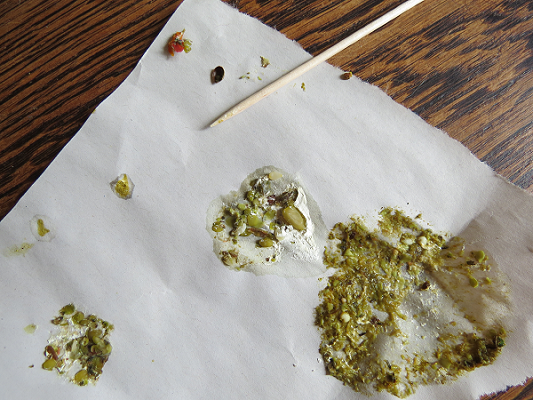Abnormal Droppings in Birds
What are the components of a normal dropping?
There are three components to normal droppings. The first is the fecal (or stool) component. For most pet birds, this is the green or brown solid part. The color may vary with the type of food being fed. The second component is the urate or solid urine. Unlike most animals, birds, in their attempt to conserve water, produce a solid urate component to the dropping. The urates are usually white and are composed of uric acid crystals. The third component, which is often not recognized by owners, is clear liquid urine. It is important for owners to become familiar with their bird’s normal droppings, as they provide important clues to illness or wellness
What are the components of a normal dropping?
There are three components to normal droppings. The first is the fecal (or stool) component. For most pet birds, this is the green or brown solid part. The color may vary with the type of food being fed. The second component is the urate or solid urine. Unlike most animals, birds, in their attempt to conserve water, produce a solid urate component to the dropping. The urates are usually white and are composed of uric acid crystals. The third component, which is often not recognized by owners, is clear liquid urine. It is important for owners to become familiar with their bird’s normal droppings, as they provide important clues to illness or wellness
What are abnormal droppings?
Once you get familiar with your bird’s droppings, any deviation from normal is abnormal. If they remain abnormal for longer than 24 hours, your bird should be seen by a veterinarian promptly. Abnormal droppings include any of the following:
- Decrease in the number of droppings
- Increase in the number of droppings
- Change in color or texture of either the fecal component or the urate component
- “Bubbly” looking droppings
- Increase in the watery or liquid component (called polyuria or too much urine)
- The presence of blood
- Pea soup consistency of the feces
- Large volumes of clear liquid in the droppings
Often, when owners state that their birds have diarrhea, they actually mean that they have more water in their droppings and no real change in the stool component. True diarrhea may occur in several types of life-threatening conditions in birds. A more common sign of abnormal droppings in birds is polyuria or too much urine is expelled.

What causes abnormal droppings?
Diet can influence the appearance of droppings. If, for example, you have decided to give your bird a few blueberries, its droppings will likely be blue or purple for a short time afterward. Consuming a lot of fresh fruit, including apples, watermelon, peaches, or grapes, will result in a large amount of urine.
Other causes of an abnormal fecal component include intestinal diseases, liver diseases, bacterial or viral infections, and parasitic infections. Chlamydiosis, or parrot fever, a common cause of liver disease, may produce lime-green droppings in some birds. Both the stool and urate components may be lime-green with this condition.
“Other causes of an abnormal fecal component include intestinal diseases, liver diseases, bacterial or viral infections, and parasitic infections.”
Excess urine in the droppings may be an indication of kidney disease if the fruit intake has been minimal over the last 24 hours. Some toxins can cause kidney damage with the first symptom being watery stools.
Some birds with heavy metal (often lead) poisoning produce red or black droppings from the presence of blood in the urine or stool.
How will my veterinarian determine the cause of the abnormal droppings?
Your veterinarian may suggest a variety of tests to help pinpoint the cause of the abnormal droppings. A complete blood count (CBC) is often recommended to check for evidence of an infection. A blood chemistry profile may be done to assess liver and kidney function as well as blood levels of protein, calcium, glucose, sodium, and potassium. Radiographs (x-rays) may be recommended to see if an internal disease or metal toxicity is causing the abnormal droppings.
Evaluation of the droppings under a microscope (after it has been stained with Gram’s stain) can be performed to look for yeast, abnormal bacteria, and other abnormal cells. A microscopic examination of the unstained feces (called a direct fecal smear) may be done to check for parasites. The droppings may be cultured at a laboratory if a bacterial or yeast infection is suspected.
Specific disease testing may also be required to arrive at the final diagnosis.
Can my bird be treated?
Depending on the diagnosis, most birds with abnormal droppings are successfully treated once the cause of the abnormal droppings is determined. Consenting to the recommended tests is critical for your veterinarian to correctly diagnose and treat your bird. Many cases have more than one factor causing the abnormal droppings, so it is common for an avian veterinarian to run several tests.
If you observe changes in your bird’s droppings, consult your veterinarian. Some of these conditions are life-threatening if left untreated, so time is of the essence!
